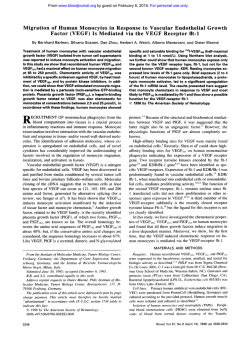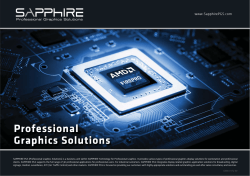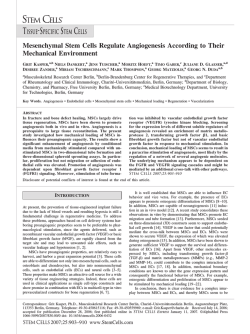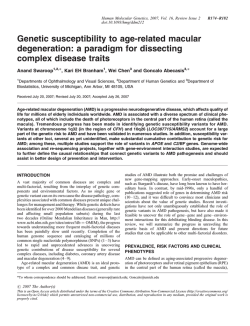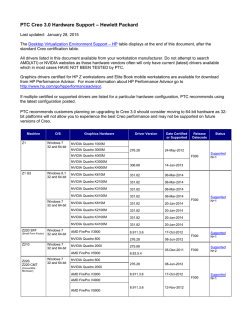
Dr. Polly A. Quiram
Age Related Macular Degeneration: Overview of AMD Update on Established Treatments and Evolving Therapies and Evolving Therapies Impact Classification – Classification – Dry and Wet Pathophysiology Treatment for Wet What drug? What drug? What interval? Is treatment effective? Making the decision to treat Polly A. Quiram MD, PhD Vitreoretinal Surgery, PA VRS Update Saturday, Jan 31st 2015 Treatment for Dry Novel therapies you will hear about AMD Classification Age‐related Macular Degeneration (AMD) Two main types of AMD Dry = ~ 90% of those affected #1 cause of blindness in those >65 years old #1 cause of blindness in those >65 years old This group expected to grow most rapidly in the This group expected to grow most rapidly in the next 30 years next 30 years Large % of Medicare $ spent fighting this disease Vision loss due to atrophy ~10% of those with severe vision loss Wet = ~ 10% of those affected Vision loss from bleeding and leakage from abnormal blood vessels ~90% of those with severe vision loss Dry AMD with Atrophy AMD Possible Risk Factors Dry AMD with Drusen Non‐‐modifiable Non Genetic Gender –– female Gender Age WetAMD with heme, fibrosis Modifiable Diet – low anti‐ Diet – low anti‐oxidant intake Cigarette smoking Cigarette smoking –– 4x Physical activity/obesity Vision not affected 1 AREDS II Results Wet AMD: Why does this happen? Lutein (10mg)/Zeaxanthin (10mg)/Zeaxanthin (2mg) No beta‐‐carotene No beta No additive improvement with omega 3 Development of CNV CNV is more than a vascular disease‐ complicated process CNV is a complex process that also involves nonvascular components RPE cells Macrophages and other inflammatory cells p g y Myofibroblasts Oxidative Stress may contribute to CNV Oxidative Stress Involves components of wound healing response Inflammation Angiogenesis Fibrosis Drusen accumulate between Bruch´s membrane and RPE: Abnormalities in complement cascade also involved – CHF and ARMS2 genetic markers CNV Progression Complement deposition with loss of complement regulation Oxidative and inflammatory processes Blood‐retina barrier break down AMD Treatment Options Oxidative Stress Lampa Inflammatory Mediators and Proangiogenic Cytokines VEGF Fovista Inappropriate Vessel Growth There is currently no true cure for macular degeneration Exudation and Hemorrhage Discoid Scar Formation Bainbridge JW et al. Clin Sci. 2003;104:561-575. Schlingemann RO. Graefes Arch Clin Exp Ophthalmol. 2004;242:91-101. Ferris FL III et al. Arch Ophthalmol. 1984;102:1640-1642. Ambati J et al. Surv Ophthalmol. 2003;48:257-293. 2 Wet AMD: Anti‐VEGF Agents Treatment for Wet What drug? VEGF: vascular Avastin endothelial growth factor Lucentis g Controls growth of abnormal blood vessels in Eylea What interval? wet AMD Inhibiting VEGF prevents Monthly – fixed interval Monthly – PRN Extend and treat and targets newly formed blood vessels What if it doesn’t work Switch therapies Ranibizumab (Lucentis™) Bevacizumab (Avastin®) What drug? Anti-VEGF-A Murine Mab VIEW IVAN HARBOR ANCHOR 7 up PRONTO CATT LUCAS (~150 kDa) Lucentis (ranibizumab) (48 kDa) Affinity maturation (140x) Insertion of murine anti-VEGF-A sequences into a full-length human IgG framework Humanization Avastin (bevacizumab) (149 kDa) Presta, LG, 1997. Cancer Res.57:4593; Chen Y. 1999 J.Mol. Biol.293:865 Comparison of AMD Treatments Trials (CATT) Lucentis‐Avastin Trial Ranibizumab (Lucentis) 0.5 mg (n=240) Sham (n=238) 15 +6.6* 10 5 0 Humanization rhu Fab V1 Insertion of murine anti-VEGF-A sequences into a human FAb framework Mean Change in VA over Time ETDRS S letters 2 4 6 8 10 12 14 16 18 20 22 24 21.4 letter benefit * P<0.01 -5 Patients treated with Lucentis and Avastin have identical visual outcomes -10 −14.9 -15 Month Note: Vertical bars are ± one standard error of the mean. Supported by Cooperative Agreements from the National Eye Institute, National Institutes of Health, DHHS 3 Change in Visual Acuity‐ GEE Model Eylea ‐ Aflibercept All Groups All Groups ––Averaged over Weeks 12 ,24, 36, 52 15 Lucentis Monthly Avastin Monthly Lucentis PRN Avastin PRN Le etters 10 7.2 7.3 6.4 6.1 (0.7) (0.8) (0.6) (0.7) 1 2 3 4 5 6 7 8.5 +8.5 8.0 +8.0 6.8 +6.8 5.9 +5.9 5 1 2 3 4 5 6 7 Fusion protein of key domains from human VEGF receptors 1 and 2 with human IgGFc Fc VEGF Trap Kd < 1 pM Blocks all VEGF-A isoforms and placental growth factor (PlGF) High affinity - binds VEGF-A and PlGF more tightly than native receptors Binds VEGF between its arms without risk of complex formation 0 0 4 8 12 16 20 24 28 32 36 40 44 48 52 VEGFR-1 Kd 10-30 pM Week Intravitreal aflibercept is specially purified and formulated to be isoosmotic for intravitreal injection VEGFR-2 Kd 100-300 pM Equivalent, prn 4-5 fewer injections, more eyes completely dry with Lucentis, no SS diff SAEs Proportion of Patients Who Gained > 15 letters* at Week 52 Mean Change in Visual Acuity 10.9* 2q4 10 8 6 4 8.1 7.9† 6.9† Rq4 2q8 0.5q4 9.7† 94 9.4 8.9† 7.6† 0.5q4 R 4 Rq4 2q8 2q4 VIEW 1 (n=1210) 2 0 0 4 8 12 16 20 24 28 32 36 40 44 48 52 12 10 8 6 4 VIEW 2 2 (n=1202) 0 0 4 8 12 16 20 24 28 32 36 40 44 48 52 9.3 8.7 8.4 8.3 Integrated (n=2412) LOCF; Full analysis set; *P = 0.0054 vs. Rq4 †P = NS vs. Rq4 2q4 Rq4 2q8 0.5q4 Minor intergroup differences are not reproduced between studies VIEW 1 VIEW 2 Integrated Proportion of Patients E TD R Sletters 12 RBZ 0.5q4 IAI 2q4 IAI IAI 0.5q4 2q8 RBZ 0.5q4 IAI 2q4 IAI IAI 0.5q4 2q8 RBZ 0.5q4 IAI 2q4 IAI 0.5q4 IAI 2q8 *Compared to baseline; LOCF; Full Analysis Set Wet AMD: Lucentis efficacy Anti VEGF efficacy (Lucentis/Avastin/ Lucentis/Avastin/Eylea Eylea): ): 25‐40% visual 25‐ 40% visual improvement improvement >90% visual >90% visual stabilization >90% visual stabilization Best treatment to Best treatment to date date If all are the same, why not just use Avastin? Different mechanism of action 4 Avastin vs Lucentis vs Eylea Cost Monthly PRN Extend and Treat Reduce risk of endophthalmitis Prevent additional damage due active CNVM Reduce vision loss secondary to possible VEGF related atrophy diminished therapeutic response to a drug following repeated administration over time Insurance coverage Access to safely compounded Avastin Efficacy Efficacy in certain ARMD subtypes in certain ARMD subtypes Tachyphylaxis What interval? Retina. Jun 2009; 29(6): 723––731. Retina. Jun 2009; 29(6): 723 Durability? The PrONTO Study Visual Acuity Results at Month 12 (N=40) Number o of Letters Gained “If I want to avoid recurrences, why not just inject monthly” Day 14 Mean + 6 letters p< 0.001 Month 12 Mean +9.3 letters p< 0.001 Mean Median 0 1 2 3 4 5 6 7 8 9 10 11 12 Months Since Initial Injection Fung et al. AJO 2007;143(4):566-583 Marina/Anchor – 12 injections, PRN – mean of 6 injections Change in Visual Acuity‐ GEE Model LUCAS All Groups All Groups ––Averaged over Weeks 12 ,24, 36, 52 15 Le etters Lucentis Monthly Avastin Monthly Lucentis PRN Avastin PRN 10 7.2 7.3 6.4 6.1 (0.7) (0.8) (0.6) (0.7) 8.5 +8.5 8.0 +8.0 6.8 +6.8 5.9 +5.9 5 0 0 4 8 12 16 20 24 28 32 36 40 44 48 52 Treat and extend protocol validated with Level 1 evidence Monthly until dry, extend by 2 weeks until 3 months Lucas‐ extend and treat, +8 letters Lucas‐ Anchor –– monthly, Anchor monthly, lucentis lucentis +10 letters Ivan‐‐ monthly,PRN Ivan monthly,PRN, , lucentis lucentis, , avastin avastin +7 +7‐‐8 CATT ‐‐ Monthly, PRN, CATT Monthly, PRN, lucentis lucentis, , avastin avastin +6 Week January 2015 Volume 122, Issue 1, Pages 146– 146–152 Equivalent, prn 4-5 fewer injections, more eyes completely dry with Lucentis, no SS diff SAEs 5 LUCAS Evidence CATT, IVAN, 7 UP – CATT, IVAN, 7 UP – progression of dry component of ARMD with long term treatment CATT and IVAN CATT and IVAN Pts that underwent monthly injections Pts that underwent monthly injections –– more atrophy than atrophy than prn prn group 1/3 pts increase in atrophy Majority of pts with gradual, sustained visual loss January 2015 Volume 122, Issue 1, Pages 146–152 Percent with Geographic Atrophy Percent with Geographic Atrophy Geographic Atrophy Same Regimen for 2 Years Baseline Week 104 33 34 Atrophy following anti‐VEGF ?disease process ?Macular atrophy associated with CNVM ?Anti VEGF Increased atrophy with monthly vs prn Increased atrophy with monthly vs prn dosing Risk for GA in CATT trial Ophthalmology, 2014 36-107 000 104 Management of ARMD One dosing strategy or drug is not appropriate for every patient “Customizable therapy” “C i bl h ” Based on experience of treating thousands of patients What drug/overtreat What drug/ overtreat//undertreat undertreat/stop? /stop? 6 20/100 20/25 Cases Case 1 – Case 1 – 67 year old recently retired male presents with loss of vision OD Dr. X is doing these injections. Can I get my injections with him? Patient returns 1 year later Loss of vision OS Patient returns with end stage scar OD Patient now wit h high risk PED OS 20/25 Patient returns with end stage scar OD 7 Recommendation Returns 1 year later Patient with high risk ARMD OS Disciform scar OD Requires close monitoring RTC 2 months or sooner if changes Presents with loss of vision OS s/p 3 avastin s/p 3 avastin injections with injections with Dr.X Dr.X – sent for emergency referral, 20/100 Now Disciform scar OD, poor vision with active lesion OS active lesion OS –– Avastin in not working! Switch to Switch to Eylea Eylea 20/20 Pt getting monthly Eylea, increase in SRF when extends to q5weeks Case 2 I saw Dr. X for glasses. He did the same scan in the office and says I don’t need these injections anymore. 82 year old woman with bilateral active CNVM s/p avastin CNVM s/p avastin X 25 20/25 OU W Worsening despite monthly injections‐ Worsening despite monthly injections i d i hl i j i ‐ tachyphylaxis Switch to Eylea Switch to Eylea Wet ARMD has periods of quiescence/activity Some patient require hypervigilant monitoring/aggressive treatment 8 Vision declined to 20/30 following 3 monthly injections of avastin Doing well on Eylea Doing well on Eylea Insurance changes terms Insurance changes terms –– pt now has 20% copay and doesn’t qualify for assistance program Wants to switch back to Avastin 3 monthly injections of avastin VA declined to 20/40 Case 3 Stable for two months on Avastin, but then significantly worsens OD – 20/25 OD – 20/25 ‐‐‐‐‐ ‐‐‐‐‐20/30 20/30 OS – 20/25 OS – OS 20/25‐‐‐‐‐‐ ‐‐‐‐‐‐20/40 20/40 79 year old author/medical malpractice lawyer treated with lawyer treated with avastin avastin q4 q4‐‐6 weeks 20/25 OD, 20/200 OS Now has secondary insurance that covers Eylea Not every drug works for every patient, tailor management 9 Significant worsening despite monthly treatment with Avastin Switch to Switch to Eylea Eylea Stable with q4‐6 week Stable with q4‐ 6 week Eylea Eylea Relatively quiescent disease If develops more active disease ‐‐ decrease If develops more active disease i interval l Treatment of Wet ARMD summary It is complicated! One dosing strategy or drug is not appropriate for every patient i f i “Customizable therapy” Periods of inactivity/activity Patients can have very poor outcomes without close monitoring CNV Progression Oxidative Stress Lampa Inflammatory Mediators and Proangiogenic Cytokines W at is o t e o i o ? What is on the horizon? VEGF Fovista Inappropriate Vessel Growth Exudation and Hemorrhage Discoid Scar Formation Bainbridge JW et al. Clin Sci. 2003;104:561-575. Schlingemann RO. Graefes Arch Clin Exp Ophthalmol. 2004;242:91-101. Ferris FL III et al. Arch Ophthalmol. 1984;102:1640-1642. Ambati J et al. Surv Ophthalmol. 2003;48:257-293. 10 Clinical Trials in the Pipeline‐ Drugs you will be hearing about….. “Extended release” medications for wet ARMD Ophthotech – “Fovista” – Anti ‐PDGF Dry ARMD – trials ongoing Acucela‐ emixustat – modulate visual cycle, decrease A2E (toxic fluorophores) accumulation Lampalizumab – anti‐factor D, Mahalo decrease 20% Fovista + anti‐VEGF Monotherapy with Anti‐ with Anti‐VEGF may not be adequate Chronic treatment results in maturation of CNVM –– Chronic treatment results in maturation of CNVM pericytes Combination treatments alters NV Anti Anti ‐‐ PDGF PDGF‐‐B/PDGFR B/PDGFR‐‐β – β – strip strip pericytes pericytes Anti Anti‐‐VEGF VEGF –– regression of neovascularization g Now pericyte Now pericyte‐‐deficient vessels are more permeable and susceptible to anti‐VEGF therapy and susceptible to anti‐ Decrease scarring and atrophy MDRTC‐ Macular Degeneration Research and MDRTC‐ Treatment Center Penfold PL et al. Clin Exp Immunol. 2000;121:458-465. Kaiser PK. Curr Med Res Opin. 2005;21:705–713. Clinical Trials in the Pipeline‐ Drugs you will be hearing about….. Abicipar – DARPin (Allergan Allergan)) Engineered mimetic protein, high affinity REACH study DRY ARMD Trials Conbercept C b t – “Lumitin L iti ” Lumitin” Higher affinity anti Higher affinity anti‐‐ VEGF PHOENIX trial PHOENIX trial –– approved in China Lampalizumab (anti‐factor D): Selective inhibitor of the alternative complement pathway Classical pathway C1q Alternative pathway C3 MBL pathway fD Amplification C3a Inflammation Bb C2a C3b AFD fB fH C4b C3b C5 C5a Inflammation MAC* C5b Bb C2a C3b C3b C4b C3b fH AFD fB fD Molecule Fab of a humanized monoclonal antibody Targets ccomplement factor D of the Targets alternative pathway Wet AMD: It’s complicated! Wet ARMD is chronic disease with periods of Target Complement factor D is a rate‐‐limiting Complement factor D is a rate enzyme in the alternative pathway and y p y present in relatively low abundance Scientific Rationale Genetic polymorphisms in alternative complement pathway proteins are associated with the risk of AMD Complement hyperactivity has been implicated in AMD No animal models Preserve the RPE, photoreceptors and choroid by modulating the immune system Genetic associations ‐‐ ARMS2, CFH: modulate the Genetic associations complement system complement system Lampalizumab‐‐ antifactor D Lampalizumab quiescence and activity Detect it early Complex management strategies to avoid overtreat//undertreat overtreat *Membrane Attack Complex 11 AMD Classification • Two main types of AMD • Dry • Wet+Dry • ALL ARMD is Dry! • Summary All ARMD is DRY There is no “cure” Complex disease process involving complex treatment strategies to maintain vision in i i i i i i patients over the long term Evolving treatments for ARMD promising Progressive atrophy despite successful treatment of CNVM Thank you! Thank you! 12
© Copyright 2025

